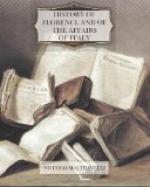Let no one, when raising popular commotions, imagine he can afterward control them at his pleasure, or restrain them from proceeding to the commission of violence. Salvestro intended to enact his law, and compose the city; but it happened otherwise; for the feelings of all had become so excited, that they shut up the shops; the citizens fortified themselves in their houses; many conveyed their valuable property into the churches and monasteries, and everyone seemed to apprehend something terrible at hand. The companies of the Arts met, and each appointed an additional officer or Syndic; upon which the Priors summoned their Colleagues and these Syndics, and consulted a whole day how the city might be appeased with satisfaction to the different parties; but much difference of opinion prevailed, and no conclusion was come to. On the following day the Arts brought forth their banners, which the Signory understanding, and being apprehensive of evil, called the Council together to consider what course to adopt. But scarcely were they met, when the uproar recommenced, and soon the ensigns of the Arts, surrounded by vast numbers of armed men, occupied the courts. Upon this the Council, to give the Arts and the people hope of redress, and free themselves as much as possible from the charge of causing the mischief, gave a general power, which in Florence is called Balia, to the Signors, the Colleagues, the Eight, the Capitani di Parte, and to the Syndics of the Arts, to reform the government of the city, for the common benefit of all. While this was being arranged, a few of the ensigns of the Arts and some of the mob, desirous of avenging themselves for the recent injuries they had received from the Guelphs, separated themselves from the rest, and sacked and burnt the house of Lapo da Castiglionchio, who, when he learned the proceedings of the Signory against the Guelphs, and saw the people in arms, having no other resource but concealment or flight, first took refuge in Santa Croce, and afterward, being disguised as a monk, fled into the Casentino, where he was often heard to blame himself for having consented to wait till St. John’s day, before they had made themselves sure of the government. Piero degli Albizzi and Carlo Strozzi hid themselves upon the first outbreak of the tumult, trusting that when it was over, by the interest of their numerous friends and relations, they might remain safely in Florence.




